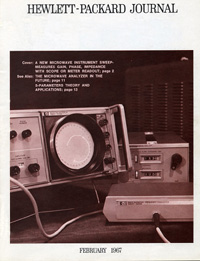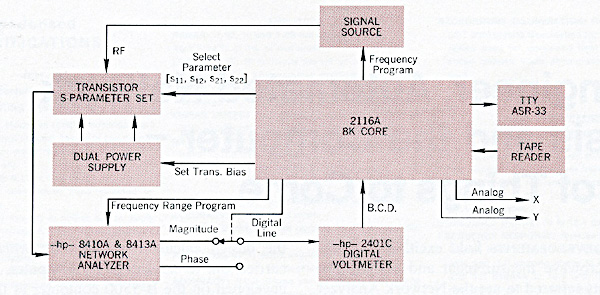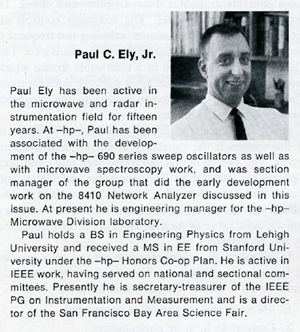Hewlett-Packard Journal February 1967

Article from Hewlett-Packard Journal February 1967 page 11.
By Paul C.Ely Jr.
Copy by permission of the Hewlett-Packard Company ™
The Engineer, Automated Network Analysis and the Computer
Signs of Things to Come...
Three new developments hold exciting possibilities for microwave measurement and design. The new developments referred to are the Network Analyzer (p. 2), the new design procedures using scattering parameters (p. 13), and an unusual new instrumentation computer recently developed by the -hp- Dymec division. The Analyzer and the s-parameter design procedures are new tools that can logically and analytically solve problems that until now had to be attacked empirically. The instrumentation computer can magnify the power and potential of these tools manyfold. Combined as tomorrow's instrument system, they offer the microwave engineer capabilities he has never had before.
To show the implications for other future instrumentation systems, we will trace the history of these three developments in our laboratory and look at the prototype system evolving therefrom.
The Network Analyzer project started several years ago with some basic ideas fortified by intuition but with little information about the increasing importance of its applications. During the course of the Analyzer project, the development of a related instrument, the RF Vector Voltmeter, was completed, and several of our engineers found that with it their efforts to advance high-frequency solid-state circuit performance were helped by using the scattering-parameter characterization of the active devices. The scattering-parameter design procedures evolved from these first measurements.
After a time, when the first prototypes of the new Network Analyzer were completed, they were pressed into service measuring active devices in chip form and thin-film components for our hybrid microcircuits. These measurements were coupled with the newly-evolved design procedures and resulted in several important advances in high-frequency integrated circuits.
As the s-parameter design techniques were applied to increasingly difficult problems, it became apparent that the design calculations and transformations could be carried out to advantage by computer. Programs were developed on the B-5500 computer at the nearby Stanford Computational Center used by our engineers. The results were quite rewarding. Later, when a computer time-share terminal was installed in the lab, several shorter programs were written and we found that the direct link between the computer and the engineer offered many advantages.
Computerized HF Transistor Measurement
The next step was obvious: as we began to think about using the newly developed instrumentation computer, we became more and more enthusiastic about the possibilities of combining the three developments. These concepts have grown until we are now evaluating the prototype system shown in the diagram. The prototype system consists of a 0.1 to 2 Gc programmable source, the 8410 Network Analyzer system, a prototype transducer instrument for transistor parameter measurement, programmable transistor bias supplies and the 2116 Instrumentation Computer. The computer controls all the conditions of measurements including test frequency, transistor bias, and the parameter to be measured. The transistor itself is inserted in a removable fixture which can be adapted to any transistor package configuration. The 8410 Network Analyzer reads into the computer through a digital voltmeter. A not insignificant advantage of the use of a computer in this system is the capability to correct measurement errors. The system is first calibrated with unity and zero s-parameter standards. The computer calculates and stores the error vector for each frequency and as the data is taken it subtracts out these values. The accuracy and dynamic range of measurement are greatly improved by this procedure. In operation the engineer can select one or a number of frequencies and bias conditions and can ask the computer to do a variety of operations such as:
1. Measure and correct the s-parameters.
2. Convert to h, y, or z-parameters.
3. Calculate maximum available power gain GA max.
4. Calculate the terminal conditions to achieve GA max.
5. Find gain-bandwidth product ft.
6. Find maximum frequency of oscillation fmax.
7. Find the biases for maximum ft and for fmax.

The engineer communicates with the system through a typewriter and the computer control panel. The programs are being improved to incorporate additional design analysis calculations and eventually some network synthesis operations. Several other organizations are working on computer-aided circuit design for high frequency applications. Bell Telephone Laboratories and Texas Instruments, for example, have particularly significant efforts in these areas. We can look for many advances in the design and synthesis techniques as this work proceeds. However, the concept as it has been developing at HP is somewhat unusual in that the experimental measurements, and the design computations are combined in one on-line system controlled directly by the engineer. The man-machine communication is in the normal language the engineer uses to solve these problems.
Future Measurement Systems
 The possibilities for this instrument system to add significantly to the power of our engineers are impressive. But beyond the value of this particular system are the implications for the whole field of high frequency instrumentation. It is easy to imagine a number of measurement systems using the on-line computer to provide new and valuable capabilities. The computer and the rest of the system combine to form a new instrument of greatly magnified capabilities, particularly if the man-machine interface is also designed for the specific function of this new instrument. We can look for several levels of microwave instrumentation systems: some will just control the measurement and perhaps correct the data; others will go on to analyze the data; the most sophisticated will carry on from the analysis into synthesis operations.
These beguiling concepts offer the opportunities for many new contributions in instrumentation developments at Hewlett-Packard and our engineers are approaching these opportunities with enthusiasm.
The possibilities for this instrument system to add significantly to the power of our engineers are impressive. But beyond the value of this particular system are the implications for the whole field of high frequency instrumentation. It is easy to imagine a number of measurement systems using the on-line computer to provide new and valuable capabilities. The computer and the rest of the system combine to form a new instrument of greatly magnified capabilities, particularly if the man-machine interface is also designed for the specific function of this new instrument. We can look for several levels of microwave instrumentation systems: some will just control the measurement and perhaps correct the data; others will go on to analyze the data; the most sophisticated will carry on from the analysis into synthesis operations.
These beguiling concepts offer the opportunities for many new contributions in instrumentation developments at Hewlett-Packard and our engineers are approaching these opportunities with enthusiasm.
Paul C. Ely


